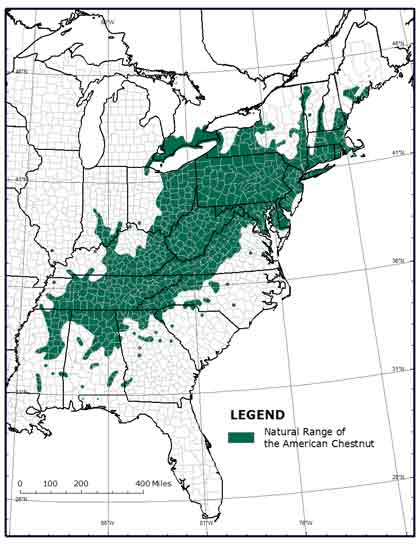 Biotechnology for Forest Health: The Test Case of the Genetically Engineered American Chestnut
Biotechnology for Forest Health: The Test Case of the Genetically Engineered American Chestnut
Executive Summary
The American chestnut, once a dominant species in eastern North American forests, was decimated in the first half of the 20th century by a fungal blight (Cryphonectria parasitica, also referred to as chestnut blight) and logging.
Researchers at the State University of New York College of Environmental Science and Forestry are developing a genetically engineered (GE) blight-resistant American chestnut (AC), and hope to win government approval for its unregulated release into the environment. If they are successful, the GE AC will be the first GE forest tree species planted specifically to spread freely through forests. Once the GE AC is released, there will be little potential to track or reverse its spread.
The GE AC is promoted as a test case to sway public opinion toward supporting the use of biotechnology for forest conservation, and to pave the way for the introduction of other GE trees. However, most other GE trees in development would be grown in industrial monoculture plantations, for the commercial production of timber, pulp and biofuels. A close look at who is promoting the GE AC reveals direct and indirect financial and other links between the nonprofit The American Chestnut Foundation, the researchers developing the GE AC, tree biotechnology company ArborGen, biotechnology company Monsanto (now Bayer), Duke Energy, government agencies, and other entities including the Forest Health Initiative and the Institute of Forest Biosciences that are deeply invested in advancing the use of biotechnology for forest restoration as a public relations tool.
The GE AC tree has been engineered with an oxalate oxidase enzyme, or OxO, derived from wheat, along with other marker and promoter genes. The OxO trait does not eliminate the pathogen, but inhibits it from spreading on the tree, making it less lethal. While tests on a small number of young GE AC trees have shown some resistance to Cryphonectria, extrapolation from these results is unreliable, given the long lifespan of AC (potentially over 200 years) and the variable conditions it encounters in nature. Efforts to genetically engineer pathogen resistance, even in common agricultural crops, have been unsuccessful because pathogens evolve to overcome plant defenses, and increasing resistance to one pathogen may lead to higher susceptibility to others. In addition, the existence of other pathogens lethal to AC, such as Phytophthera cinnamomi, as well as a variety of stresses including climate change, contribute further to the challenge of chestnut restoration, with or without genetic engineering.
The GE AC is specifically intended to be released into forests, and to spread its GE pollen and seeds. Locating and monitoring all GE AC trees and their progeny will be nearly impossible, especially over a long period of time. GE AC pollen and nuts could contaminate hybrid chestnut orchards, and spread across borders and jurisdictions. Researchers claim that a robust regulatory process will be sufficient to address risks. However, the U.S. regulatory system has no specific regulations to deal with the release of GE trees into forests. In addition, our minimal knowledge about highly complex forest ecosystems and the potential impacts of climate change make adequate risk assessments impossible. Other concerns include the safety of eating GE AC nuts or inhaling GE AC pollen, and impacts on wildlife, pollinators, other plants, soils and waterways.
The development of GE trees has been met with strong and ongoing public opposition including from scientists, foresters, and ecologists. Indigenous Peoples whose traditional lands fall in the range of AC have expressed concern about the impacts on their territorial sovereignty and right to keep GMOs off their lands.
The release of GE AC into forests would be a massive and irreversible experiment. The introduction of GE AC could not only fail, but also create new problems and exacerbate existing pressures on forest ecosystems. Forests are already threatened by unsustainable logging practices, invasive species and introduced pests and pathogens, urban sprawl, and the escalating impacts of climate change. Without solving these underlying causes of forest demise, the restoration of the American chestnut through any technology is highly improbable.
Decisions about the introduction of the GE AC will set a regulatory precedent and set the stage for the future of forest genetics. The GE AC should not be permitted for distribution. The UN Convention on Biological Diversity and forest certification regimes including the Forest Stewardship Council and Sustainable Forestry Initiative call for application of the precautionary principle to GE trees, with the FSC and SFI banning their use. The precautionary principle, which was formulated to avert harm by delaying action until safety can be proven, is the appropriate framework to apply to decision-making related to the GE AC.
Read the full report here: https://stopgetrees.org/wp-content/uploads/2019/04/biotechnology-for-forest-health-test-case-american-chestnut-report-WEB-1.pdf
